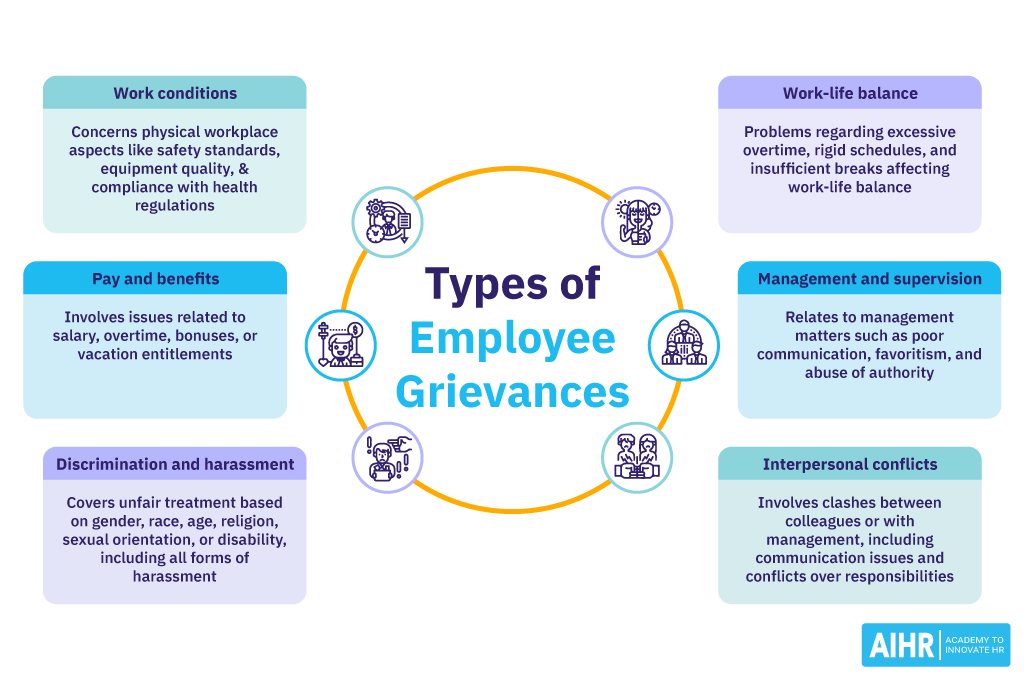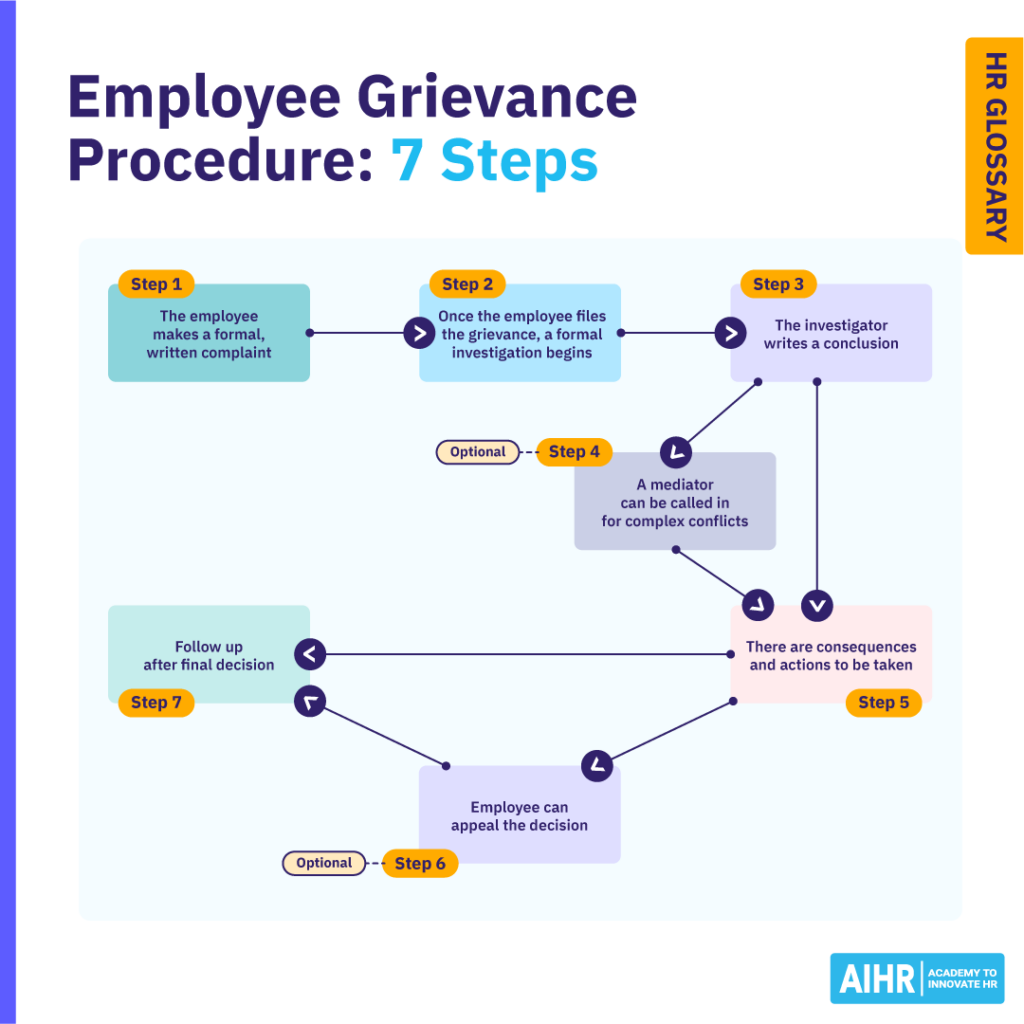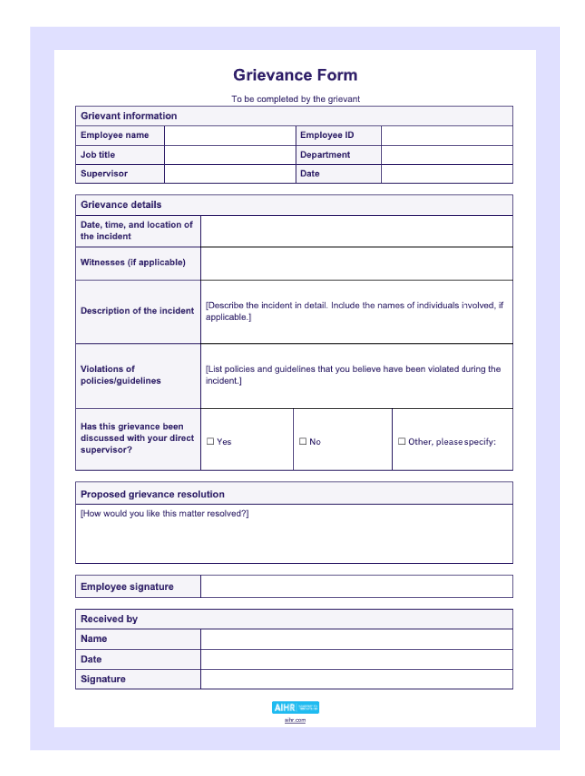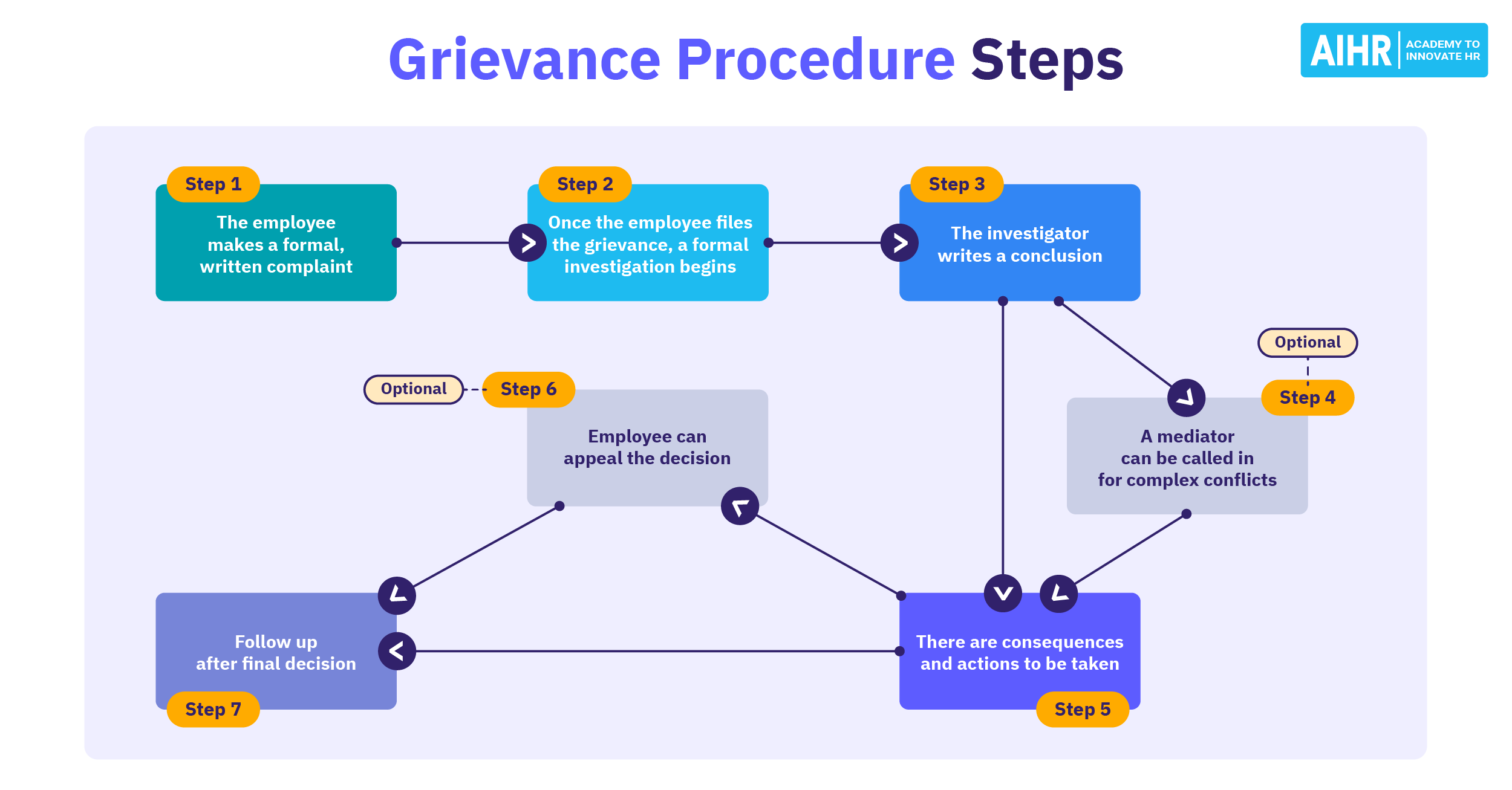Employee Grievance
What is employee grievance?
An employee grievance is a formal complaint an employee raises against their employer due to dissatisfaction with one or more aspects of their employment. This complaint typically concerns issues the employee feels are unfair, unjust, or that deviate from company policies or their employment contract.
Grievances should be addressed through a structured process that allows employees to voice their concerns clearly and seek resolution.
Types of employee grievances
Employee grievances can be categorized into several types based on their nature and the issues they address. Here are the primary types:

- Work conditions: These relate to the physical conditions of the workplace, including safety standards, equipment quality, workspace environment, and compliance with health and safety regulations.
- Compensation and benefits: These grievances involve disputes over earnings, salary adjustments, overtime pay, bonuses, and other compensation issues, as well as benefits like health insurance, retirement plans, and vacation entitlements.
- Discrimination and harassment: Complaints related to unfair treatment based on gender, race, age, religion, sexual orientation, disability, or any other protected characteristic fall into this category. It also includes all forms of harassment, whether sexual, verbal, or psychological.
- Work-life balance: This category involves concerns over excessive overtime, inflexible work schedules, insufficient breaks, and anything else that affects an employee’s ability to balance work with personal life.
- Management and supervision: Concerns related to management practices, including lack of communication, poor management style, favoritism, lack of support, or abuse of authority.
- Interpersonal conflicts: Problems between colleagues or employees and management that affect the working environment. This can include personality clashes, communication problems, or disputes over responsibilities.
Employee grievance procedure: 7 steps
A formal grievance procedure is typically initiated after informal complaints from an employee have not been resolved. While the specifics of grievance handling can differ across organizations, here is a general outline of the process.
1. The employee makes a formal, written complaint
The grievance process starts when an employee submits a formal, written complaint. While employees may initially voice their concerns verbally, it’s crucial for HR or a manager to document these concerns in writing to create a clear paper trail.
This written complaint becomes the foundation for the entire process, and it should include as many specifics as possible, such as key dates and people involved.
2. Once the employee files the grievance, a formal investigation begins
Once the grievance is filed, an investigation begins. The scope of this investigation depends on the nature of the complaint. For example, a simple payroll error might be resolved with a quick call, while more serious matters—like accusations of harassment—require a more thorough approach.
This can involve interviewing multiple people, reviewing footage or emails, and sometimes, bringing in external experts to ensure an impartial review.
3. Reaching a conclusion
After all the information has been gathered, the investigator presents their findings. In straightforward cases, like missed payments, the solution might be clear-cut. But for more complex issues—such as workplace harassment—the conclusion could be more nuanced. Sometimes both parties may share blame, or the evidence may not fully meet either side’s expectations.

4. A mediator can be called in
In more complex or emotionally charged cases, particularly those involving union agreements or sensitive issues like discrimination, a mediator might be brought in.
A mediator acts as a neutral party to help both sides reach a fair solution. In some cases, they help after both sides have presented their arguments. Other times, mediation might be a requirement before the company can come to a formal decision. If a union is involved, employees might also have a representative or lawyer alongside them during these discussions.
5. Implementing consequences
Whether through mediation or based on the investigation’s findings, the organization then decides on the appropriate action. This could be anything from a minor adjustment to more serious measures, such as disciplinary action or even termination, depending on the situation.
6. The employee can appeal
If the employee isn’t satisfied with the outcome, and the company policy or any relevant contracts allow it, they may be able to appeal the decision. In some cases, the employee might escalate the grievance to court, especially if no satisfactory resolution is reached through internal procedures.
7. Follow-up after the final decision
Once the grievance has been resolved, a follow-up is crucial. This ensures any agreed-upon actions are actually implemented. HR, union representatives, or legal teams involved in the process should check in with the employee to confirm the issue has been fully addressed and that there are no lingering concerns.
Employee grievance examples
While grievances can vary widely depending on the employer and the issue the employee is facing, there are some common examples.
- Discrimination: An employee raises a grievance as they feel they’ve been consistently overlooked for promotions due to their age, despite having comparable qualifications and performance levels to other colleagues who received promotions.
- Interpersonal conflicts: An employee files a grievance as they feel unfairly treated by their supervisor, who frequently criticizes them in front of peers and assigns them less desirable tasks compared to others in the same team.
- Working conditions: An employee files a grievance claiming the working conditions in the company warehouse are unsafe. They cite inadequate lighting and malfunctioning equipment, which they believe pose a safety risk to them and their colleagues.
- Pay and benefits: An employee raises a grievance after discovering they are being paid significantly less than new hires with similar roles and qualifications. The employee contends that this pay discrepancy is unfair and demotivating, particularly since they’ve been with the company for several years and have consistently received positive performance reviews.
Employee grievance form
Using a standardized (digital) employee grievance form makes it easier to gather relevant information from your employees and track the status of their complaints. You can check out our Word template and use it to create your own grievance form.

What to include in your employee grievance policy
As you create your grievance policy, make sure it includes all the information both your HR department and employees need to manage grievances as they arise.
- Definition of grievance: The policy should clearly define what constitutes a grievance. This could include issues like harassment, discrimination, unfair treatment, safety concerns, and violations of company policies.
- Procedures for filing a grievance: Clarify what steps employees must take when filing a grievance, including any evidence or information they must provide and whom to contact (typically a supervisor or HR representative).
- Confidentiality: Assurance that all grievance submissions will be handled discreetly to protect the privacy of those involved.
- Investigation process: What process will the company go through to evaluate and respond to the grievance? Who should be involved in that process? Clearly lay it out as part of your grievance policy.
- Resolution and decision-making: Provide information on how decisions will be made following the investigation and what kind of resolutions can be expected. Ensure the policy includes a commitment to treating all employees fairly and recognition that they all have the same right to have their grievances taken seriously.
- Appeals process: If an employee is dissatisfied with the outcome of an investigation, the policy should outline how they can appeal the decision and the procedures involved in the appeals process.
- Anti-retaliation policy: Note that the company prohibits retaliation against any employee who files a grievance, participates in an investigation, or supports another employee in their grievance.
FAQ
A grievance in the workplace refers to a formal complaint raised by an employee against their employer regarding an aspect of their employment they believe is unfair or unjust or violates their rights or conditions of employment.
When an employee files a grievance, they formally submit a complaint concerning issues like unfair treatment, violations of company policy, or unsafe working conditions. This process initiates a formal investigation and resolution procedure within the organization to address and rectify the employee’s concerns.
An example of an employee grievance is a situation in which an employee files a complaint against their employer after experiencing harassment at work and feeling the employer has not adequately addressed the issue.
Employers typically follow a structured process to resolve employee grievances. This procedure includes acknowledging the complaint, conducting a thorough investigation to gather facts, discussing the findings with all involved parties, and deciding on an appropriate resolution. This process seeks to address the grievance fairly and maintain a positive work environment.









